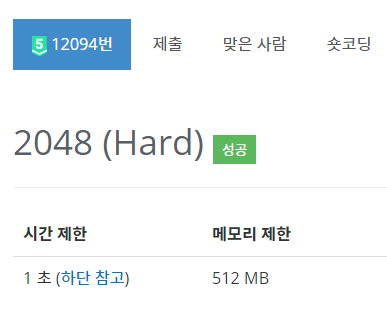문제

보드의 크기와 보드판의 블록 상태가 주어졌을 때, 최대 10번 이동해서 만들 수 있는 가장 큰 블록의 값을 구하는 프로그램을 작성하시오.
문제접근
- https://velog.io/@embeddedjune/알고리즘-백준-Bruteforce-12100-2048easy 문제의 심화버전이다. 이동횟수가 기존 5에서 10으로 늘어났는데 시간은 여전히 1초이므로 이전 코드를 빠르게 풀기 위한 최적화 방법을 강구해야한다.
최적화 방법
- 우선, 벡터는 일반 배열보다 많이 느리다. 벡터를 일반 배열로 바꾼다면 실행속도 측면에서 많이 개선할 수 있다.
- 만일 이동을 했는데도 이동하기 전과 달라진 것이 없다면 추가로 depth를 늘려서 탐색을 진행하고, 다시 게임판을 원상복귀할 필요가 없다.
- 만일 이번 depth에서 구할 수 있는 최대 블럭이 다른 재귀에서 구한 최대 블럭보다 작을 것이라 예상된다면 굳이 이번 재귀를 수행할 필요가 없다.
코드
#include <iostream>
#include <queue>
using namespace std;
int N, ans;
int board[20][20];
int maxPerDepth[11];
void action(int actionSelector) {
queue<int> q;
switch(actionSelector) {
case 0: // 왼쪽으로 움직이는 경우
for (int y = 0; y < N; ++y) {
for (int x = 0; x < N; ++x) {
if (board[y][x]) q.push(board[y][x]);
board[y][x] = 0;
}
int curRowIdx = 0; // 현재 i번째 행의 인덱스
while (!q.empty()) {
int tempVar = q.front(); q.pop();
if (board[y][curRowIdx] == 0) board[y][curRowIdx] = tempVar;
else if (board[y][curRowIdx] == tempVar) board[y][curRowIdx++] += tempVar;
else board[y][++curRowIdx] = tempVar;
}
}
break;
case 1: // 오른쪽으로 움직이는 경우
for (int y = 0; y < N; ++y) {
for (int x = N - 1; x >= 0; --x) {
if (board[y][x]) q.push(board[y][x]);
board[y][x] = 0;
}
int curRowIdx = N - 1; // 우측 끝 인덱스부터 큐에 저장한다.
while (!q.empty()) {
int tempVar = q.front(); q.pop();
if (board[y][curRowIdx] == 0) board[y][curRowIdx] = tempVar;
else if (board[y][curRowIdx] == tempVar) board[y][curRowIdx--] += tempVar;
else board[y][--curRowIdx] = tempVar;
}
}
break;
case 2: // 위쪽으로 움직이는 경우
for (int x = 0; x < N; ++x) {
for (int y = 0; y < N; ++y) {
if (board[y][x]) q.push(board[y][x]);
board[y][x] = 0;
}
int curColIdx = 0; // 현재 i번째 열의 인덱스
while (!q.empty()) {
int tempVar = q.front(); q.pop();
if (board[curColIdx][x] == 0) board[curColIdx][x] = tempVar;
else if (board[curColIdx][x] == tempVar) board[curColIdx++][x] += tempVar;
else board[++curColIdx][x] = tempVar;
}
}
break;
case 3: // 아래쪽으로 움직이는 경우
for (int x = 0; x < N; ++x) {
for (int y = N - 1; y >= 0; --y) {
if (board[y][x]) q.push(board[y][x]);
board[y][x] = 0;
}
int curColIdx = N - 1;
while (!q.empty()) {
int tempVar = q.front(); q.pop();
if (board[curColIdx][x] == 0) board[curColIdx][x] = tempVar;
else if (board[curColIdx][x] == tempVar) board[curColIdx--][x] += tempVar;
else board[--curColIdx][x] = tempVar;
}
}
break;
}
}
bool isSame(int tmp[20][20]) {
for (int y = 0; y < N; ++y)
for (int x = 0; x < N; ++x)
if (tmp[y][x] != board[y][x]) return false;
return true;
}
int findMaxElement() {
int var = 0;
for (int y = 0; y < N; ++y)
for (int x = 0; x < N; ++x)
var = max(var, board[y][x]);
return var;
}
void copyArray(int lhs[][20], int rhs[][20]) {
for (int y = 0; y < N; ++y)
for (int x = 0; x < N; ++x)
lhs[y][x] = rhs[y][x];
}
void solve(int depth) {
// [기저 1] - 현재 게임판에서 최대 원소 추출하고,
// 현재 depth에서 만들어질 것으로 예상되는 최대 원소보다 작거나 같다면 탐색 불필요.
int checkCurrMaxValue = findMaxElement();
if (checkCurrMaxValue <= maxPerDepth[depth]) return;
// [기저 2] - 10번 움직였다면, 최대값 구해서 깊이 별 최대 원소값 갱신한다.
if (depth == 10) {
ans = max(ans, checkCurrMaxValue);
int expectMaxPerDepth = ans;
while (depth > 0) {
maxPerDepth[depth--] = expectMaxPerDepth;
expectMaxPerDepth /= 2;
}
return;
}
int currBoard[20][20];
copyArray(currBoard, board); // 현재 depth의 게임판을 저장한다.
for (int i = 0; i < 4; ++i) { // 취할 수 있는 행동은 4가지
action(i); // 게임판을 움직인 뒤, 변화가 없다면 다음 액션으로 진행.
if (isSame(currBoard)) continue;
solve(depth + 1); // 다음 depth로 이동하고,
copyArray(board, currBoard);// 완전탐색 원칙에 따라 원상복귀 후 다음 경우의 수(액션) 진행.
}
}
int main() {
ios::sync_with_stdio(false); cin.tie(nullptr); cout.tie(nullptr);
cin >> N; // 보드의 크기 (N X N)
for (int y = 0; y < N; ++y)
for (int x = 0; x < N; ++x)
cin >> board[y][x];
ans = findMaxElement(); // ans의 초기값 할당 (안해주면 100%에서 오답. (반례: 1x1 칸일 경우))
solve(0);
cout << ans << '\n';
}결과

